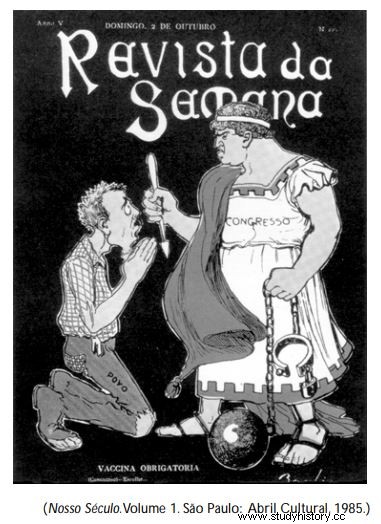
The above cartoon, first published in 1904, refers to mandatory vaccination, which was an important motivation for the Vaccine Revolt. This movement came about as a result of:
(A) imposition of a health policy by the State
(B) appeal by the population for better living conditions
(C) reaction of the uninformed people to power civilization of the elites
(D) appreciation of health issues by the National Congress
Question 02 - IFBA 2017 - Integrated -
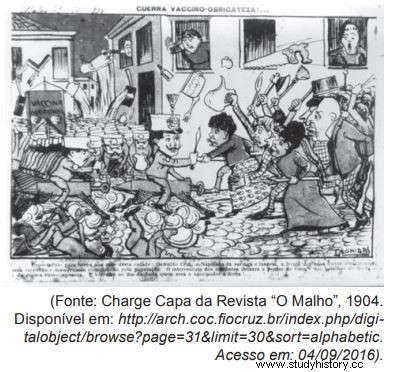 The image above represents one of the uprisings in Brazilian history, early 20th century:the Vaccine Uprising. Taking place in Rio de Janeiro, this movement demonstrates the most recurrent problems in Brazil during this period, among which we can highlight:
The image above represents one of the uprisings in Brazilian history, early 20th century:the Vaccine Uprising. Taking place in Rio de Janeiro, this movement demonstrates the most recurrent problems in Brazil during this period, among which we can highlight:A) The urban reforms promoted at the time, which displaced hundreds of residents of the tenements.
B ) Several popular revolts against the maintenance of slavery at the beginning of the Republic.
C) The unpopular measures of the government at the time, Deodoro da Fonseca, which established the continuity of the census vote.
D) Popular dissatisfaction against the Republican Regime and the centralization of the Moderating Power.
E) The end of mandatory vaccination, represented in the image, and the control, already effective in this period, of diseases such as smallpox.
Question 03 - FCC - 2018 - TRT - 15th Region (SP) - Among the causes of the Vaccine Revolt (1904), there are
(A) the authoritarian measures taken by the state government in the process of cleaning the city and the social revolts caused by the “encilhamento”, an economic policy that caused inflation , bankruptcies and unemployment at the beginning of the Republic.
(B) the popular indignation caused by the repression of the uprising of black sailors against corporal punishment on Navy ships, and the urban barricades resulting from the police intervention in the Rio de Janeiro hills, in persecution of capoeiras.
(C) the imposition of popular housing rules, based on the current sanitary policy, and the popular rebellion organized by the monarchist party, which accused the emerging Republic of anti-constitutionalism and militarism.
(D) the urban social tensions caused by the displacement of poor populations from the center due to the urban reforms in Rio de Janeiro and the political tensions involving positivist and liberal groups were in the First Republic.
(And) the dissatisfaction of cariocas with the attempted military coup by the supporters of President Prudente de Moraes, and the popular reaction caused by the mandatory vaccination against Yellow Fever, extended to all neighborhoods of the city.
Question 04 - ENEM 2011 -
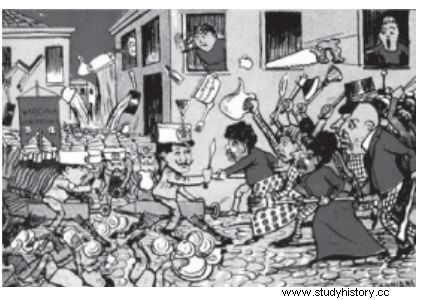
Charge cover of the magazine “O Malho”, 1904. Available at:http:// 1.bp.blogspot.com.
The image represents the demonstrations in the streets of the city of Rio de Janeiro, in the first decade of the 20th century, which were part of the Vaccine Revolt. Considering the political-social context of the time, this revolt reveals
A) the population's dissatisfaction with the benefits of an authoritarian urban modernization.
B) the poor population's awareness of the need for vaccination to eradicate of epidemics.
C) the guarantee of the democratic process established with the Republic, through the defense of the population's freedom of expression.
D) the planning of the republican government in the area of health, which covered the population in general.
E) support for the republican government for the attitude of vaccinating the entire population instead of privileging the elite.
Question 05 - UFU 1998-2 - History - The Vaccine Revolt was an "almost unique example in the history of the country of a successful popular movement based on the defense of the right of citizens not to be arbitrarily treated by the government".
CARVALHO, J. Murilo de. The bestialized Rio de Janeiro and the Republic that was not. São Paulo, Cia Das Letras, 1987, p.138-9 About this movement, mark the INCORRECT statement. A) Workers, merchants, students, street urchins and the so-called "dangerous classes" participated in the revolt, looting, burning trams and vandalizing public buildings.
B) Unemployment, caused by the government's anti-industrial policy, was one of the reasons that explained the Vaccine Revolt, as it increased the misery of the population and aggravated the climate of social tension.
C) Another important factor for the outbreak of the movement was the modernization of the city of Rio de Janeiro, under the government of Mayor Pereira Passos. , which led to the demolition of tenements, displacing thousands of poor people.
D) The revolt against the mandatory vaccination was a movement of former slaves from the hills of Rio de Janeiro, assuming a character of racial struggle.
E) Resistance to mandatory vaccination against smallpox was the pretext used by the protesters to protest against the lack of democracy, the arbitrariness and violence of the government, the brutal increase in prices and low wages.
Question 06 - Mackenzie 2008 - Day 1 -
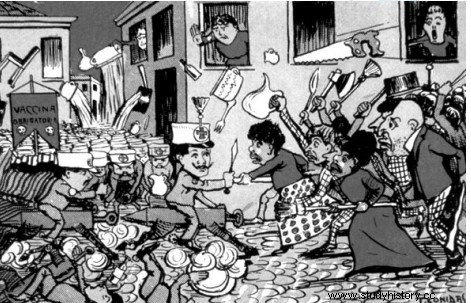
The illustration given refers to a serious social disturbance that occurred in the early years of the 20th century in Riode Janeiro, involving the figure of the eminent sanitarian Osvaldo Cruz. Of this disturbance, it is incorrect to say that
a) in its origins, there was the discontent of the poor population of the city, mainly because of the urban remodeling plan implemented in the government of Rodrigues Alves (1902-1906), which, among other things, evicted part of this population from the blocks of central neighborhoods to open avenues and widen the streets.
b) the declaration of mandatory vaccination was the immediate reason why the people, already dissatisfied with the expropriations and demolitions, rebelled against the sanitary agents, transforming Rio de Janeiro was in the midst of violent confrontations with the police.
c) the arbitrary and violent way in which the “sanitary brigades” carried out the vaccination – invasion of homes to forcibly vaccinate people – provoked the indignation of the population, that, moreover — not adequately clarified — he was unaware of the true medical effects of the measure.
d) the violent reaction of the population must be understood in a broader social context, of reaction to a process of modernization that excluded the urban environment, aggravated by the discretionary attitude of the public power.
e) the level of violence that the revolt reached, evidenced the extreme conservatism of the population, contrary to any form of modernization or progress, whether urban or scientific.
Question 07 - FUVEST 2009 - At the beginning of the 20th century, outbreaks of smallpox and yellow fever claimed thousands of victims in the city of Rio de Janeiro. In the same period, the activities of the Brigadas Mata-Mosquitos, the mandatory vaccination against smallpox and the remodeling of the port region and the city center generated dissatisfaction among the lower classes and among some politicians. Rui Barbosa, writer, jurist and politician, said this about the smallpox vaccine:“...the recklessness, violence, tyranny that he ventures into has no name in the category of crimes of power (... ) with the introduction, in my blood, of a virus under whose influence there are the most well-founded fears that it is a conductor of illness or death.”
Considering this historical context and the ways of transmission and prevention of these diseases, It is correct to say that:
A) yellow fever is transmitted through the air and the streets widened by the remodeling of the port and central area of the city would allow for a healthier coexistence between pedestrians.
B) the principle of action of the vaccine was understood by Rui Barbosa, who warned about its effects and led the Vaccine Revolt in the National Congress.
C) the imposition of the vaccine added to popular dissatisfaction generated by the remodeling of the port and central areas of the city, contributing to the outbreak of the Vaccine Revolt.
D) smallpox is transmitted by mosquitoes and the widening of the streets, promoted by urban remodeling, eliminated the larvae that accumulated in the old alleys and alleys.
E) the remodeling of the port and central area of the city , in addition to widening the streets, it renovated popular housing and tenements to eliminate outbreaks of disease transmission.
Question 08 - FUVEST 2003 - 1st phase - “It is not by chance that the Brazilian authorities receive unanimous applause from the international authorities of the great powers, for the implacable and effective energy of their sanitizing policy [...]. The same happens with the repression of the popular movements of Canudos and Contestado, which in the rural context [...] meant practically the same as the Vaccine Revolt in the urban context”.
Nicolau Sevcenko. The vaccine revolt. According to the text, the Vaccine Revolt, the Canudos and Contestado movements were seen internationally as a) provoked by the massive exodus of populations leaving the countryside towards the cities soon after abolition.
b) retrograde, because they hindered the modernization of the country.
c) resulting from Oswaldo Cruz's sanitary policy.
d) indications that slavery and the empire were coming to an end to give way to free work and the republic.
/>e) conservative, because they threatened the advance of US capital in Brazil.
Question 09 - Albert Einstein (Medicine) - 2016 - “The revolt did not aim at power, it did not intend to win, it could not win anything. It was just a scream, a convulsion of pain, a vertigo of horror and indignation. How far can a man stand to be trampled on, despised, and frightened? How much suffering does it take for a man to dare to face death without fear? And when the audacity reaches that point, he is able to sense the presence of the power that afflicts him in its smallest signs:in electric light, in elegant gardens, in statues, in crystal windows, in decorated park benches, in public clocks, in trams, on cars, on marble facades, in police stations, post offices and vaccination posts, on uniforms, in ministries and on signposts.”
Nicolau Sevcenko. The vaccine revolt. São Paulo:Brasiliense, 1984, p. 68. The text deals with the Vaccine Revolt, which took place in 1904, and links the popular reaction against mandatory vaccination to a) the irrationality of the population of Rio de Janeiro and the benefits that the vaccine would bring to public health.
b) to the cleaning program undertaken by the mayor of Rio de Janeiro and the broad clarification of public opinion regarding the benefits of the vaccine.
c) the participation of employees from all sectors of the federal government in the campaign to eradicate epidemic outbreaks.
d) to Rio de Janeiro's redevelopment project and the various forms of segregation and social exclusion that it promoted.
Question 10 - FGV-SP 2003/2 - 1st phase - The city is a monster where epidemics take shelter dancing magnificent sabbats, a melancholy village of old and stooped buildings, peeling through the plaster, sordid alleys stinking."
Our Century. São Paulo:Abril Cultural/Círculo do Livro,
This was how the journalist Luiz Edmundo described Rio de Janeiro at the beginning of the 20th century. In fact, the so-called Vaccine Revolt broke out in the city in 1904. This popular rebellion was provoked:
a) by deep discontent with the dengue epidemic that afflicted the city.
b) the government's decision to limit the importation of yellow fever vaccines.
c) the government's refusal to promote vaccination against the bubonic plague.
>d) for the cancellation of vaccination against infantile paralysis.
e) for the decree that made vaccination against smallpox mandatory.
Question 11 - UECE 2020/1 - The Vaccine Revolt, which was an important social event, A) took place among sailors from lower social classes who refused to be vaccinated against yellow fever, since the officers were not obliged to do so. B) took place in the hinterlands of Cariri Ceará due to the government's decision to impose vaccination against the bubonic plague on Father Cícero's followers. mandatory by it. D) took place in Rio de Janeiro due to the mandatory vaccination against smallpox and the urban and sanitary reforms initiated by President Rodrigues Alves.
Question 12 - ENEM 2020 Digital - Calling the reporter a “citizen”, in 1904, the capoeirado preto justified the revolt:it was to “not go around saying that the people are sheep. Every now and then it's good for the black people to show that they know how to die like a man!”. For him, the vaccination itself was unimportant—although he wouldn't by any means let the hygiene men put that iron in his crotch. The most important thing was “to show the government that it doesn't put its foot on the people's neck”. CARVALHO, J. M. The bestialized:Rio de Janeiro and the Republic that was not. Sao Paulo:Co. das Letras, 1987 (adapted).
The aforementioned Revolt, which took place in the city of Rio de Janeiro at the beginning of the Republic, was characterized by a) agitation encouraged by doctors. b) popular resistance attitude. c) strategy developed by the workers. d) immigrant survival tactics. e) insurgency action by traders.
Question 13 - COLUNI - UFV 2021 - Analyze the text and image below:
The Brazilian First Republic was a period marked by great contrasts. At the same time that it is possible to notice a great euphoria in relation to new technologies, civilization, progress and modernity, it is also a moment marked by the less positive effects of the changes that were undertaken by political agents and their impacts on the lives of thousands. of people. Among several social movements that took place at that time, we can mention the Vaccine Revolt that took place in Rio de Janeiro in 1904, as a result of the reaction of the population of Rio de Janeiro to the actions of modernization, urban remodeling and sanitary measures carried out by its rulers. and other authorities, among which the public health doctor Oswaldo Cruz stands out.
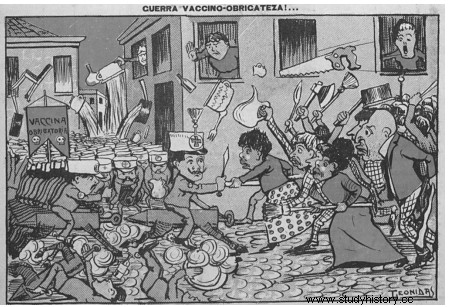 “Short show on the streets of this city:Oswaldo Cruz, Napoleon of the syringe and lancet, in front of his mandatory forces, will be received and expressed with courage by the population. The interesting aspect of the combats will leave out of sight the flower battles and the Russo-Japanese war. And we'll see at the end of the party who will be the forced vaccinator!” Available at:http//memoria.bn.br/docreader/docreader.aspx?bib=116300&pesq&pagfis=3567. Accessed on:12 Jan. 2021.
“Short show on the streets of this city:Oswaldo Cruz, Napoleon of the syringe and lancet, in front of his mandatory forces, will be received and expressed with courage by the population. The interesting aspect of the combats will leave out of sight the flower battles and the Russo-Japanese war. And we'll see at the end of the party who will be the forced vaccinator!” Available at:http//memoria.bn.br/docreader/docreader.aspx?bib=116300&pesq&pagfis=3567. Accessed on:12 Jan. 2021. Regarding the Vaccine Revolt, analyze the statements below:I. The defense of urban health and the modernization of the city, promoted by the authorities, made it possible to install a sanitation campaign and mandatory vaccination against smallpox . II. The population was informed of the importance of vaccination through a broad awareness campaign conducted by government agencies and disseminated through newspapers and magazines. III. The discontent with urban reforms, the unpopularity of the government and the mandatory vaccination caused the triggering of a popular uprising in the city of Rio de Janeiro. It is CORRECT what is stated in:a) I, II and III. b) I and II only. c) II, only. d) I and III, only.
CHECK
01 - A
02 - A
03 - D
04 - A
05 - D
06 - E
07 - C
08 - B
09 - D
10 - E11 - D12 - B13 - D
